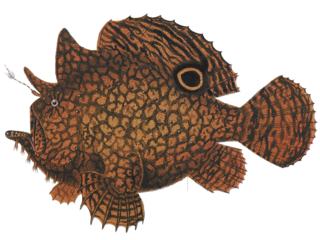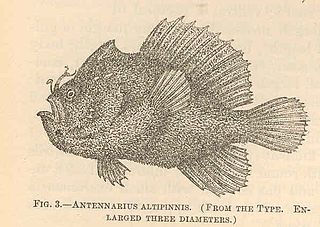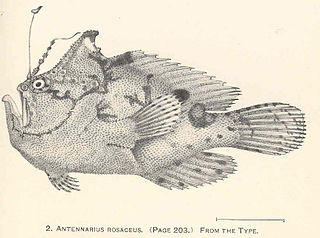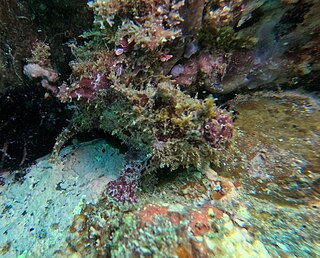
The spotfin frogfish, also known as the big-spot angler, coin-bearing frogfish, darkspot frogfish, ocellated angler, ocellated fringed fishing frog, opulent frogfish, spotfin angler or white-finger anglerfish, is a species ray-finned fish belonging to the family Antennariidae, the frogfishes. The spotfin frogfish is found in scattered locations the eastern Atlantic, Indian and western Pacific Oceans.

The striated frogfish or hairy frogfish is a species of marine ray-finned fish belonging to the family Antennariidae, the frogfishes. This species is found in the Indo-Pacific and eastern Atlantic Ocean.

Fowlerichthys radiosus, the singlespot frogfish or big-eyed frogfish, is a species of marine ray-finned fish belonging to the family Antennariidae, the frogfishes. This fish is found in the Western Atlantic Ocean.

Fowlerichthys is a genus of marine ray-finned fishes belonging to the family Antennariidae, the frogfishes. The fishes in this genus are found the Atlantic, Indian and Pacific Oceans.

Nudiantennarius is a monospecific genus of marine ray-finned fish belonging to the family Antennariidae, the frogfishes. The only species in the genus is Nudiantennarius subteres, the deepwater frogfish. This fish is found in the Western Pacific Ocean.

Abantennarius sanguineus, the bloody frogfish or sanguine frogfish, is a species of marine ray-finned fish belonging to the family Antennariidae, the frogfishes. The sanguine frogfish is found in the eastern Pacific Ocean.

Randall's frogfish is a species of marine ray-finned fish belonging to the family Antennariidae, the frogfishes. This species is found in the Indo-Pacific region.
Abantennarius drombus, freckled frogfish or Hawaiian freckled frogfish is a species of marine ray-finned fish belonging to the family Antennariidae, the frogfishes. The freckled frogfish is endemic to the Hawaiian Islands.

Antennarius biocellatus, the brackish water frogfish, brackish water anglerfish, freshwater frogfishtwinspot frogfish or fishing frog, is a species of euryhaline ray-finned fish belonging to the family Antennariidae, the frogfishes. This fish is found in the Western Pacific Ocean.

Antennarius indicus, the Indian frogfish, is a species of marine ray-finned fish belonging to the family Antennariidae, the frogfishes. The Indian frogfish is found in the Indian Ocean.

Antennarius pardalis, the leopard frogfish or peixe pescador, is a species of marine ray-finned fish belonging to the family Antennariidae, the frogfishes. This species is found in the eastern Atlantic Ocean.

Antennarius pauciradiatus, the dwarf frogfish or smallspot frogfish, is a species of marine ray-finned fish belonging to the family Antennariidae, the frogfishes. This species is found in the western Atlantic.
Abantennarius analis, the tailjet frogfish, tailjet anglerfish or dwarf frogfish, is a species of marine ray-finned fish belonging to the family Antennariidae, the frogfishes. This species is found in the eastern Indian Ocean and the western Pacific Ocean.

Abantennarius dorehensis, the New Guinean frogfish, bandtail frogfish, Dorei frogfish or white-spotted frogfish, is a species of marine ray-finned fish belonging to the family Antennariidae, the frogfishes. The New Guinean frogfish is found in the Indo-Pacific region.

Abantennarius rosaceus, the rosy frogfish, rosy anglerfish, pink anglerfish or spiny tufted frogfish, is a species of marine ray-finned fish belonging to the family Antennariidae, the frogfishes. The rosy frogfish is found in the Indo-Pacific region.

Fowlerichthys avalonis, the roughbar frogfish or roughjaw frogfish, is a species of marine ray-finned fish belonging to the family Antennariidae, the frogfishes. This fish is found in the Eastern Pacific Ocean, where it is the most widespread frogfish species.

Echinophryne mitchellii, the long-spined frogfish, bristly frogfish, Mitchell's anglerfish, Mitchell's frogfish, prickly angler fish or spinycoat anglerfish, is a species of marine ray-finned fish belonging to the subfamily Histiophryninae in the family Antennariidae, the frogfishes. These fishes are endemic to the temperate waters of southern Australia.

Lophiocharon trisignatus, the spot-tail anglerfish, rough anglerfish or three-spot frogfish, is a species of marine ray-finned fish belonging to the subfamily Histiophryninae in the family Antennariidae, the frogfishes. This fish is found in the Indo-Pacific region.

Abantennarius is a genus of marine ray-finned fishes belonging to the family Antennariidae, the frogfishes. The fishes in the genus are found in the Indian, Pacific and, one species, in the Western Atlantic Oceans.

Antennarius scaber, the splitlure frogfish or striated frogfish, is a species of marine ray-finned fish belonging to the family Antennariidae, the frogfishes. This species is found in the Western Atlantic Ocean and was previously considered to be a synonym of Antennarius striatus.


















